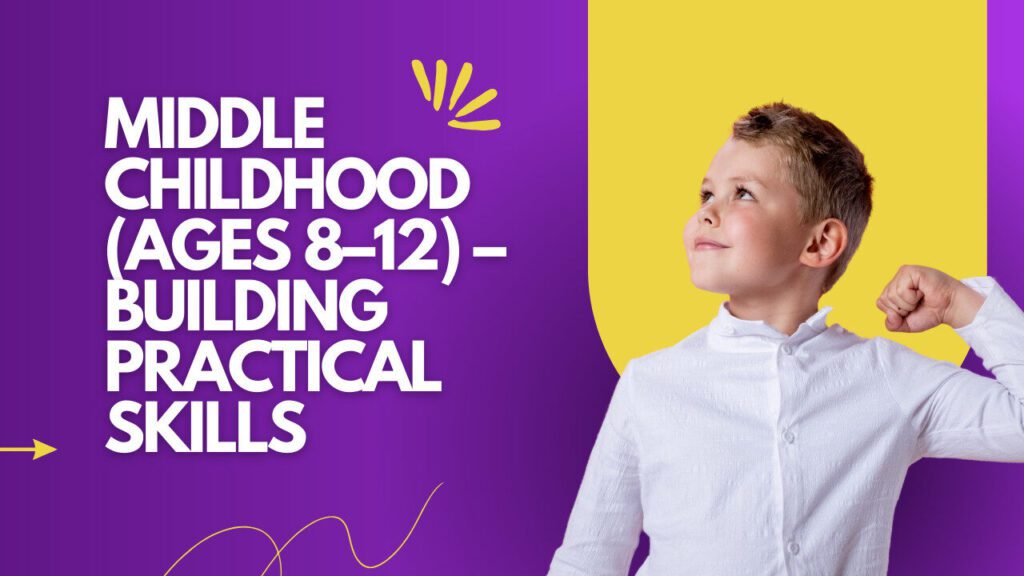
Why Money Lessons Start at Home
Money is one of those subjects kids will use every single day of their lives but rarely learn about in school. In America, children can graduate knowing algebra or Shakespeare but not how to budget, save, or avoid debt. That’s why parents and families become the first and most powerful teachers of money.
Money Lessons Are Really Life Lessons
When kids learn about money at home, they’re not just learning about dollars. They’re learning:
- Responsibility – understanding choices have consequences.
- Patience – saving today for something tomorrow.
- Discipline – resisting impulses in a world built on advertising.
- Confidence – knowing how to handle money without fear.
These lessons shape adulthood. Kids who grow up with strong financial skills often become adults who avoid credit card traps, build savings, and live with less stress.

The Foundation – Early Childhood (Ages 3–7)
Even preschoolers can start learning money basics. At this stage, it’s not about numbers or bank accounts but about concepts and habits.

1. Introducing Money Through Play
- Toy cash registers help kids role-play buying and selling.
- Play store games teach the idea that money exchanges for goods.
- Coin recognition – kids learn to tell the difference between pennies, nickels, dimes, and quarters.
2. The First Lesson: Money is Limited
Kids should see that money doesn’t appear magically. For example:
- If they want two toys but only have enough for one, let them decide.
- This teaches trade-offs – a cornerstone of financial decision-making.
3. Using Allowance as a Teacher
Parents often debate whether to give allowance. The key isn’t the amount but the lesson structure:
- $1 or $2 a week can be divided into categories: Spend, Save, Share.
- This system teaches balance early—money isn’t only for buying things.

Middle Childhood (Ages 8–12) – Building Practical Skills
By this age, kids can handle more responsibility. They start to understand numbers, math, and goals.
1. Opening a Savings Account
Take them to a local bank or credit union to open a child savings account. Watching their balance grow, even slowly, builds excitement and shows the value of saving.
2. Chores & Earning Money
- Tie some allowance or extra pay to chores.
- Kids learn money is earned, not given.
- Example: $5 for mowing the lawn, $2 for washing the car.
3. Goal-Setting: Short-Term vs. Long-Term
Help them set goals:
- Short-term: a toy, a video game, a sports item.
- Long-term: bike, iPad, trip.
Give them a chart or jar to track progress. This makes money visual and tangible.
4. First Lesson on Budgeting
Teach them to split their money into envelopes or digital “jars”:
- Spending: for small things now.
- Saving: for bigger goals.
- Giving: for charity or helping others.
This helps them see that money has multiple purposes.
Teenagers (Ages 13–18) – Real-World Preparation
This is the critical stage. Teenagers are exposed to peer pressure, online shopping, and ads everywhere. They’re also close to handling money independently—jobs, debit cards, even preparing for college.
1. Part-Time Jobs
Encourage teens to work: babysitting, lawn care, tutoring, retail, food service. Jobs teach:
- Time value of money.
- Discipline and scheduling.
- The pride of earning their own income.
2. Debit Cards & Banking
Set them up with a debit card connected to a youth account. Teach them to:
- Track spending with online banking apps.
- Check balances before spending.
- Avoid overdrafts.
3. The First Budget
Guide them to create a budget based on their earnings. Example:
- 50% spending (fun, food, outings).
- 40% saving (future goals, college fund).
- 10% giving (donations, community).
4. Warning About Credit Cards
High schools rarely teach this, but credit card debt can trap young adults. Teach teens:
- Credit cards are tools, not free money.
- Interest builds fast.
- Only spend what you can pay in full monthly.
Even if they don’t get a card yet, this lesson can save them years of financial stress later.
Young Adults (Ages 18–22) – Launching Independence
At this point, kids are heading into adulthood—college, jobs, or both. They’ll face tuition, rent, and real bills. Parents can help ease this transition with guidance.
1. Managing First Paychecks
- Help them divide income into bills, savings, and spending.
- Show them how taxes reduce take-home pay—so they aren’t surprised.
2. Student Loans Reality Check
If they borrow for school, walk them through repayment math. For example:
- $30,000 in loans at 5% means about $320/month for 10 years.
- Seeing this number helps them treat borrowing seriously.
3. Emergency Fund Mindset
Even if it’s just $500 to start, building a small emergency cushion prevents turning to credit cards when life happens.
4. Building Credit Responsibly
This is the right time to introduce credit cards, but with strict rules:
- Use it for one small recurring bill (like Netflix).
- Pay off every month.
- Build a credit history without falling into debt.

Everyday Opportunities to Teach Kids Money
Teaching doesn’t always require lessons. Kids learn most by watching their parents.
1. Grocery Store Lessons
- Give them a budget and let them help shop.
- Compare prices: store brand vs. name brand.
- Show them how coupons or sales make a difference.
2. Family Budget Discussions
Don’t hide money topics. Talk about:
- Saving for vacations.
- Why you wait before buying big things.
- The importance of bills like electricity and rent.
3. Modeling Healthy Money Behavior
Kids copy parents. If you:
- Save regularly.
- Budget openly.
- Avoid debt traps.
They will too.
Teaching Generosity & Gratitude
Money isn’t only for personal gain—it’s also a tool for impact. Teaching kids to share and give builds compassion.
- Encourage them to donate part of allowance.
- Let them choose a charity or cause.
- Show them how giving creates joy, not loss.
This balances the idea that money equals power with the reality that money equals responsibility.
The Psychology of Money & Storytelling as a Tool
If Part 1 was about the what and how of teaching money, Part 2 is about the why kids behave the way they do with money—and how parents can use psychology and stories to make lessons stick.
Why Psychology Matters in Money Education
Money is emotional. Adults often spend, save, or borrow not because of math but because of feelings—fear, pride, excitement, or even guilt. Kids are no different.
When you teach money at home, you’re not just transferring knowledge—you’re shaping:
- Beliefs (money is good or bad).
- Habits (spend first vs. save first).
- Confidence (I can handle money vs. money is confusing).
The earlier these mindsets are built, the stronger they stay.
1. Teaching Kids Through Stories
Children love stories. They remember lessons better when wrapped in a character or narrative. You can use this power to teach about money.
Example Stories:
- The Ant and the Grasshopper – saving vs. spending.
- A Tale of Two Friends – one saves $1 a day, another spends it. After a year, who’s happier?
- Grandparent Stories – share how family members survived tough times by budgeting or saving.
When money is explained as a human journey—not just numbers—kids pay attention.
2. Linking Money to Feelings
Instead of teaching kids “money is about dollars,” show them how money is about choices and feelings.
- Saving = Security (peace of mind).
- Spending = Joy (fun but short-lived).
- Debt = Stress (carrying a heavy backpack you can’t put down).
- Investing = Growth (like planting a seed that turns into a tree).
This emotional connection helps kids see money as a tool—not something to fear.
3. The Power of Modeling Behavior
Parents may not realize it, but kids watch every move. If you complain about bills, swipe credit cards freely, or argue about money, kids absorb those messages.
Instead, let them watch you:
- Put money into savings before spending.
- Talk positively about budgeting (“this helps us go on vacation”).
- Avoid “we’re broke” language. Replace it with “we’re saving for something important.”
Kids mirror what they see more than what they’re told.
Teaching Kids About Digital Money
The America of 2025 isn’t the America of 1995. Cash is disappearing. Kids today see Venmo, Apple Pay, Cash App, and crypto more than they see coins and bills. Parents must teach not only the basics of cash but also the digital future of money.
1. Explaining “Invisible Money”
Digital transactions are tricky because kids don’t see money leaving their hands. Swipe a card, tap a phone, and the toy is theirs. This creates a false sense of endless money.
To fix this:
- Show them the connection between a swipe and the bank account balance.
- Let them track spending on a banking app.
- Use visual tools (like charts) to make invisible money visible.
2. Debit vs. Credit – The Big Lesson
Kids growing up today may confuse debit and credit. Break it down simply:
- Debit = your money now.
- Credit = borrowed money you must pay back.
Role-play: Pretend they “borrow” $10 from you. If they don’t return it on time, add “interest” ($1 extra). Suddenly, they feel how credit works.
3. Digital Allowance
Instead of handing out cash, many families now use apps to transfer allowance digitally. Pros:
- Easier tracking.
- Kids see balances on their phones.
- Prepares them for real-world digital banking.
Just make sure they also understand the value of physical money so they don’t grow up disconnected from real-world costs.

Teaching About Peer Pressure & Consumer Culture
America’s consumer culture is everywhere—TikTok trends, celebrity lifestyles, ads before every YouTube video. Kids face pressure not only to spend but to spend now.
1. Explaining Advertising Tricks
Sit with your kids and watch a commercial together. Ask:
- What are they trying to sell you?
- How do they make it look cooler than it really is?
- Do you think you’d still want it if your best friend didn’t have it?
This turns ads into a learning moment instead of a temptation.
2. The “Want vs. Need” Game
When kids ask for something, pause and ask:
- Is this a want or a need?
- If it’s a want, how long are you willing to wait for it?
Over time, they’ll internalize the difference.
3. Building Confidence Against Peer Pressure
Teach kids to say:
- “I can’t buy that right now, I’m saving for something else.”
- “I don’t need to spend money to have fun.”
Role-playing these conversations prepares them for real-life pressure.
Introducing Kids to Investing
Many parents avoid this topic, thinking it’s “too advanced.” But kids are curious, and investing is just another form of planting seeds. The earlier they understand, the stronger their future.
1. Explaining Investing with Simple Analogies
- Stocks = Owning a slice of a company.
- Bonds = Lending money and earning interest.
- Investing = Planting seeds that grow into trees.
2. Hands-On Investing Activities
- Pick a company your kid loves (Disney, Nike, Apple).
- Show them how its stock goes up or down.
- Create a mock portfolio with imaginary money.
3. Compound Interest as Magic
Explain compound interest as “money that makes money.”
- If you save $100 and earn $10 interest, next year you earn interest on $110—not just $100.
- Repeat the cycle, and the money grows faster like a snowball rolling downhill.
This sparks curiosity about long-term growth.

Teaching Kids About Giving Back
Money lessons aren’t complete without generosity. In America, where kids are often surrounded by abundance, learning the value of giving is crucial.
1. Sharing Builds Gratitude
When kids donate part of their money:
- They see they can make a difference.
- They appreciate what they already have.
2. Choosing Causes They Care About
Instead of forcing donations, let kids pick:
- Animal shelters.
- School fundraisers.
- Community food banks.
Ownership makes generosity personal.
3. Time vs. Money
Teach them that giving doesn’t always mean dollars. Volunteering time is also valuable.
Building a Family Money Culture
If Part 1 focused on foundations and Part 2 on psychology, Part 3 is about the environment kids grow up in. Just like language is learned at home, money habits are absorbed from what kids see every day.
1. Why a Family Money Culture Matters
In many American homes, money is either:
- A taboo topic (never discussed, creating mystery and fear).
- A stress trigger (arguments, panic about bills).
- A silent expectation (kids assume money just appears when parents swipe cards).
But if you build a healthy money culture, kids grow up with clarity instead of confusion. They see money not as something scary but as something manageable.
2. Normalizing Money Conversations
Start with small, casual talks:
- While shopping, mention why you chose one brand over another.
- When paying bills, explain that services like electricity and internet aren’t free.
- When saving, say: “We’re putting money aside for our summer trip.”
These micro-conversations build awareness without overwhelming them.
3. Shared Family Goals
Money becomes meaningful when it’s tied to something exciting. As a family, set one shared goal:
- A vacation.
- A backyard project.
- A new gadget everyone can use.
Put a jar or digital tracker where kids can see progress. Every contribution feels like teamwork.
4. Family Budget as a Teaching Tool
Instead of shielding kids from budgets, involve them at an age-appropriate level:
- Younger kids (6–9): Show categories like “food, fun, savings.”
- Tweens (10–13): Ask for input on entertainment spending.
- Teens (14–18): Let them plan parts of the grocery budget or compare subscription services.
A family budget becomes less about rules and more about shared decision-making.
Turning Daily Life Into Financial Lessons
Teaching money doesn’t always require charts or lectures. The best lessons happen naturally in everyday life.
1. Grocery Store Economics
Every trip to the store is a classroom:
- Compare prices between brands.
- Show unit pricing (“per ounce” vs. “per package”).
- Give kids a budget to pick snacks within limits.
This teaches trade-offs, value, and prioritizing.
2. Meal Planning as Cost Control
Sit together to plan weekly meals. Kids learn:
- Cooking at home costs less than take-out.
- Planning avoids waste.
- Choices impact savings.
Let them calculate how much was saved by cooking instead of ordering pizza.
3. Family Entertainment
Instead of just going out, frame it as a decision:
- “A movie at the theater costs $60 for tickets and snacks. A movie night at home costs $15. Which do we prefer this week?”
This teaches value-based choices, not deprivation.
4. Chores & Allowances
Allowance systems teach responsibility—but only when tied to lessons. Options:
- Fixed Allowance: Weekly amount, teaching consistency.
- Chore-Based: Pay per task, linking money to effort.
- Hybrid: Small guaranteed amount plus extra for optional work.
Whichever system you choose, always include a rule for saving a portion.
5. Car Costs & Travel
For older kids, involve them in the reality of car ownership:
- Gas prices.
- Insurance.
- Repairs.
They’ll understand that cars aren’t just freedom—they’re responsibility.
6. Birthdays & Holidays
Celebrations are prime lessons in both spending and generosity:
- Give kids a budget for gifts.
- Show them how to shop thoughtfully instead of quickly.
- Encourage them to make something if money is tight.
This develops creativity alongside money sense.
Practical Tools for Teaching at Home
To reinforce lessons, you can use simple, low-cost tools.
1. Visual Trackers
Kids understand visuals better than numbers:
- Savings thermometer charts.
- Jars labeled “Save, Spend, Share.”
- Digital trackers with colorful progress bars.
Watching savings grow creates motivation.
2. Games & Simulations
Board games like Monopoly, The Game of Life, or even custom family games can mimic real financial scenarios. For younger kids, invent simple games:
- “If you save three tokens, you can trade them for a bigger reward.”
- “Spend tokens early, and you miss out later.”
These build patience and decision-making.
3. Family Money Meetings
Hold short, fun “money meetings.” Keep it light—10 minutes is enough. Agenda ideas:
- Check progress toward family goals.
- Let kids suggest how to spend part of the entertainment budget.
- Celebrate savings milestones with small rewards.
Meetings give kids a sense of control and belonging.
4. Using Technology Wisely
Kids love screens, so use apps that teach budgeting or savings. Many child-friendly financial apps now offer:
- Prepaid debit cards with parental controls.
- Spending reports.
- Goal trackers.
These mimic adult tools but with guardrails.
Building Habits That Last
The goal isn’t to raise kids who just know what money is—it’s to raise kids who naturally act wisely with money. That comes from habits.
1. The Save-First Rule
Every dollar earned (from chores, gifts, or jobs) should be split:
- 50% spending.
- 40% saving.
- 10% giving.
Percentages can change, but the habit of saving first is key.
2. Avoiding Impulse Spending
Teach the 24-hour rule: If you want something, wait a day. If you still want it, consider buying. If not, you’ve avoided regret.
3. Setting Long-Term Goals
Encourage kids to save for big purchases instead of constant small ones. This builds patience and planning skills.
4. Reflection & Discussion
After a financial choice, ask:
- Was that a good use of money?
- How did it make you feel?
- Would you do it differently next time?
Reflection cements lessons
